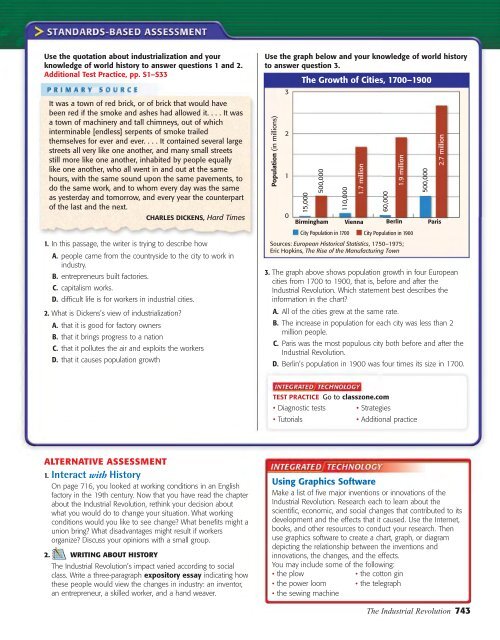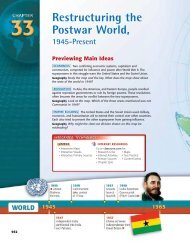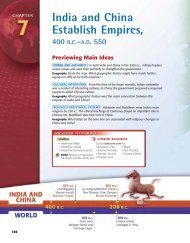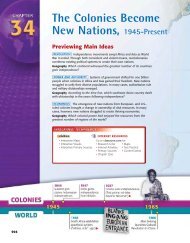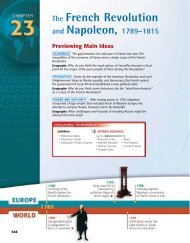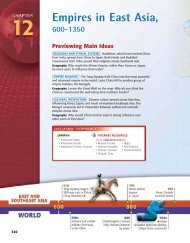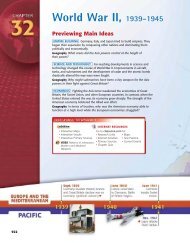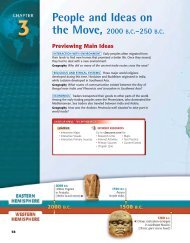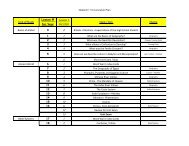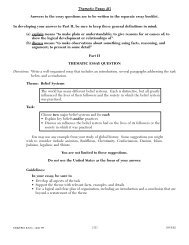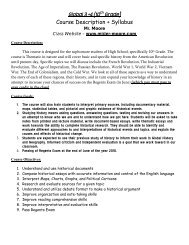The Industrial Revolution, 1700– 1900 Previewing Main Ideas
The Industrial Revolution, 1700– 1900 Previewing Main Ideas
The Industrial Revolution, 1700– 1900 Previewing Main Ideas
Create successful ePaper yourself
Turn your PDF publications into a flip-book with our unique Google optimized e-Paper software.
Use the quotation about industrialization and your<br />
knowledge of world history to answer questions 1 and 2.<br />
Additional Test Practice, pp. S1–S33<br />
It was a town of red brick, or of brick that would have<br />
been red if the smoke and ashes had allowed it. . . . It was<br />
a town of machinery and tall chimneys, out of which<br />
interminable [endless] serpents of smoke trailed<br />
themselves for ever and ever. . . . It contained several large<br />
streets all very like one another, and many small streets<br />
still more like one another, inhabited by people equally<br />
like one another, who all went in and out at the same<br />
hours, with the same sound upon the same pavements, to<br />
do the same work, and to whom every day was the same<br />
as yesterday and tomorrow, and every year the counterpart<br />
of the last and the next.<br />
CHARLES DICKENS, Hard Times<br />
1. In this passage, the writer is trying to describe how<br />
A. people came from the countryside to the city to work in<br />
industry.<br />
B. entrepreneurs built factories.<br />
C. capitalism works.<br />
D. difficult life is for workers in industrial cities.<br />
2. What is Dickens’s view of industrialization?<br />
A. that it is good for factory owners<br />
B. that it brings progress to a nation<br />
C. that it pollutes the air and exploits the workers<br />
D. that it causes population growth<br />
ALTERNATIVE ASSESSMENT<br />
1. Interact with History<br />
On page 716, you looked at working conditions in an English<br />
factory in the 19th century. Now that you have read the chapter<br />
about the <strong>Industrial</strong> <strong>Revolution</strong>, rethink your decision about<br />
what you would do to change your situation. What working<br />
conditions would you like to see change? What benefits might a<br />
union bring? What disadvantages might result if workers<br />
organize? Discuss your opinions with a small group.<br />
2. WRITING ABOUT HISTORY<br />
<strong>The</strong> <strong>Industrial</strong> <strong>Revolution</strong>’s impact varied according to social<br />
class. Write a three-paragraph expository essay indicating how<br />
these people would view the changes in industry: an inventor,<br />
an entrepreneur, a skilled worker, and a hand weaver.<br />
Use the graph below and your knowledge of world history<br />
to answer question 3.<br />
Population (in millions)<br />
3<br />
2<br />
1<br />
<strong>The</strong> Growth of Cities, <strong>1700–</strong><strong>1900</strong><br />
15,000<br />
500,000<br />
110,000<br />
1.7 million<br />
City Population in 1700 City Population in <strong>1900</strong><br />
3. <strong>The</strong> graph above shows population growth in four European<br />
cities from 1700 to <strong>1900</strong>, that is, before and after the<br />
<strong>Industrial</strong> <strong>Revolution</strong>. Which statement best describes the<br />
information in the chart?<br />
A. All of the cities grew at the same rate.<br />
B. <strong>The</strong> increase in population for each city was less than 2<br />
million people.<br />
C. Paris was the most populous city both before and after the<br />
<strong>Industrial</strong> <strong>Revolution</strong>.<br />
D. Berlin’s population in <strong>1900</strong> was four times its size in 1700.<br />
TEST PRACTICE Go to classzone.com<br />
• Diagnostic tests • Strategies<br />
• Tutorials • Additional practice<br />
Using Graphics Software<br />
Make a list of five major inventions or innovations of the<br />
<strong>Industrial</strong> <strong>Revolution</strong>. Research each to learn about the<br />
scientific, economic, and social changes that contributed to its<br />
development and the effects that it caused. Use the Internet,<br />
books, and other resources to conduct your research. <strong>The</strong>n<br />
use graphics software to create a chart, graph, or diagram<br />
depicting the relationship between the inventions and<br />
innovations, the changes, and the effects.<br />
You may include some of the following:<br />
• the plow • the cotton gin<br />
• the power loom • the telegraph<br />
• the sewing machine<br />
60,000<br />
1.9 million<br />
Sources: European Historical Statistics, 1750–1975;<br />
Eric Hopkins, <strong>The</strong> Rise of the Manufacturing Town<br />
500,000<br />
2.7 million<br />
0<br />
Birmingham Vienna Berlin Paris<br />
<strong>The</strong> <strong>Industrial</strong> <strong>Revolution</strong> 743


